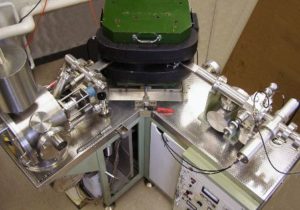 The chemical elements of matter consist of very stable atoms, such as silicon, carbon, iron, uranium, etc. However, certain elements also have an unstable or radioactive form that, under natural conditions, decays or breaks down into “daughter” products at a very uniform rate.
The chemical elements of matter consist of very stable atoms, such as silicon, carbon, iron, uranium, etc. However, certain elements also have an unstable or radioactive form that, under natural conditions, decays or breaks down into “daughter” products at a very uniform rate.
Uranium is one such element, and the radioactive form decays slowly, atom by atom, to form lead. Potassium is another, which decays to argon gas; and carbon-14 decays to nitrogen gas. Measurements of the rates at which these radioactive atoms break down have been carried out since about 1927. These rates appear to be constant under a wide variety of conditions of heat, pressure and time.
Knowing these rates, it is then possible to determine the age of any material that contains these radioactive elements. One simply measures the relative proportions of the radioactive element (the parent) and the decay product (the daughter). The more daughter element present, the older the mixture. All the other radiometric methods except the carbon-14 method give ages in terms of millions of years.
Calibration (checking against a standard) is vital to any method of scientific measurement. But there are no historically dated materials older than about 5,000 years by which these radiometric methods can be checked. The problem of calibration – and the assumptions that are made for the method to be used – are major deficiencies. They would certainly prevent the radiometric methods being used at all were it not for the fact that the long ages they yield lend support to the theory of evolution.
The first assumption is that the rate of decay has been constant for billions of years of earth’s history. Recall that these rates have only been measured over a period of 60 years at most, while the measurements of the potassium and carbon-14 rates extend over a much shorter period of time. To extend a few decades of hard data to billions of years is not good science! The rates have not necessarily been constant. For example, it is known that neutron bombardment of the earth by supernova explosions will rapidly increase the rates of decay and thus give a false impression of long ages.
The second assumption is that no daughter products existed in the beginning. No one can know this, since no one was present in the beginning as an observer. And repeating the process as a laboratory experiment would tell us nothing about the actual beginning. If, in fact, daughter elements did exist in the beginning, then the radiometric ages have no meaning. Every specimen could equally as well be only thousands of years old and not millions.
The third assumption is that radioactive decay has taken place in isolation within the rock specimen. That is, no parent or daughter has escaped, and none have been added from external sources. Not only is this unlikely, in many cases it has been shown to be untrue. One method of uranium mining today consists of forcing water through shattered rocks to dissolve the uranium salts within them. Ground water will have done the same thing. Magma or liquid rock from volcanoes beneath the sea has been shown to absorb argon gas (a daughter product) from seawater, thus giving freshly produced rock the impression of being millions of years old.
Footnotes:
Photo: Thermal ionization mass spectrometer is used for radiometric dating. (PD)
© 2021 Creation Moments. All rights reserved.
